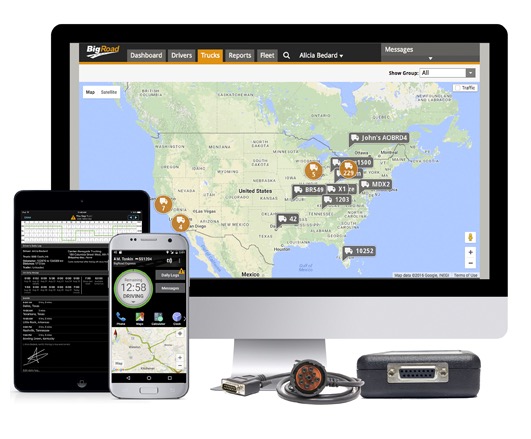Recent Posts
Electronic Logging Devices (ELD) for Fleet Management – SAE J1939 And SAE J1708/J1587 Parameters
Posted by on

An electronic logging device (ELD) is electronic hardware that is attached to a commercial motor vehicle engine to record driving hours. The driving hours of commercial drivers (truck and bus drivers) are regulated by a set of rules known as the hours of service (HOS). The Commercial Vehicle Driver Hours of Service Regulations vary in Canada and the United States. More Information...
An ELD is a device that:
- Records a commercial motor vehicle's driving time
- Records the driver's hours of operation
- Is synchronized with the engine of the vehicle
- Monitors engine data such as:
- Engine power status
- Vehicle motion status
- Miles driven
- Engine hours
In the following, I will define PGNs (SAE J1939) and PIDs (SAE J1708/J1587) I deem appropriate to provide information such as engine power status, vehicle motion status, miles driven, and engine hours. Please understand that the information provided is not guaranteed, i.e. other engineers in the business may choose different parameters.
Engine Power Status
The engine power status, regardless of SAE J1939 or SAE J1708/J1587, is a matter of great discussion between experts. There is simply no PGN/PID that would indicate engine power (in this case “power” referring to voltage supply) . Looking at the requirement “An ELD must be powered and become fully operational within one minute of the vehicle’s engine…”, this topic is more or less a system issue, i.e. assuming the device is powered by the same supply as the rest of the network, you must assure the device is ready within one minute. On the other hand, sensing the power-on status in real-time would imply that your device is already in operation.
In all consequence, as long as the device becomes fully operational within one minute of the vehicle’s engine ignition, the requirement of detecting engine power status are met.
Vehicle Motion Status
- SAE J1939:
PGN 65132 Tachograph
2 bits, Pos. 1.7 – 1.8
Message Frequency: 50 msAccording to SPN 1611:
00 – Vehicle motion not detected
01 – Vehicle motion detected
10 – Error
11 – Not availableThe SAE J1939 does not offer any information at what speed motion is detected. My suggestion, in order to fulfill the ELD mandate, would be using this information in combination with the vehicle speed using the same PGN:PGN 65132 Tachograph
2 Bytes, Pos. 7 – 8
Resolution: 1/256 km/h per bit, 0 offset - SAE J1708/J1587:
Unlike J1939, J1587 does not provide a motion status. My suggestion would be using PID 84 and determine the motion status at a certain speed.PID 84: Road Speed
1 Byte – 0.805 km/h per bit
Message Frequency: 0.1 sec
Miles Driven
- SAE J1939:
PGN 65217 High Resolution Vehicle Distance
4 Bytes, Pos. 1 – 4: Total Vehicle Distance - 5 meters/bit – 0 offset
4 Bytes, Pos. 5 – 8: Trip Distance – 5 meters/bit - 0 offset
Message Frequency: 1 sec - SAE J1708/J1587:
PID 245: Total Vehicle Distance
4 Bytes – 0.16 km/bit
Message Frequency: 10 sec
Engine Hours
- SAE J1939:
PGN 65253 Engine Hours, Revolutions
4 Bytes, Pos. 1 – 4 – Engine Hours – 1 h/bit
Message Frequency: On Request - SAE J1708/j1587:
PID 247: Total Engine Hours
4 Bytes – 0.05h/bit
Message Frequency: On Request
Vehicle Identification Number (VIN)
- SAE J1939:
PGN 65260 Vehicle Identification
Variable length, for description see SPN 237
Message Frequency: On Request - SAE J1708/J1587
PID 237 – Vehicle Identification Number
Variable Length
Message Frequency: On Request
A Comprehensible Guide to J1939
SAE J1939 has become the accepted industry standard and the vehicle network technology of choice for off-highway machines in applications such as construction, material handling, and forestry machines. J1939 is a higher-layer protocol based on Controller Area Network (CAN Bus).
It provides serial data communications between microprocessor systems (also called Electronic Control Units - ECU) in any kind of heavy duty vehicles. The messages exchanged between these units can be data such as vehicle road speed, torque control message from the transmission to the engine, oil temperature, and many more.
The information in this book is based on two documents of the SAE J1939 Standards Collection: J1939/21 - Data Link Layer J1939/81 - Network Management A Comprehensible Guide to J1939 is the first work on J1939 besides the SAE J1939 standards collection.
It provides profound information on the J1939 message format and network management combined with a high level of readability.
 Loading... Please wait...
Loading... Please wait...

